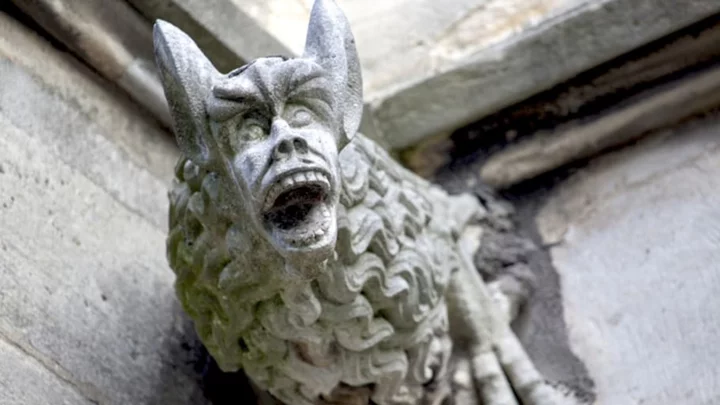Gargoyles conjure images of hideous, brooding creatures perched high above the cities and villages of the world. The most terrifying ones look as though they might break from their stone moorings and take flight. But these decorative demons are full of surprises. Read on to learn the origin of their name, their very functional purpose, and what makes a gargoyle different from a grotesque.
1. Gargoyles are there for a reason.
When gargoyles began appearing on churches throughout Europe in the 13th century, they served as decorative water spouts, engineered to preserve stone walls by diverting the flow of rainwater outward from rooftops. This function, technically speaking, distinguishes gargoyles from purely decorative stone ornaments like grotesques and bosses, although these days the term encompasses all sorts of creature carvings.
2. The name comes from a dragon-slaying legend.
The word gargoyle derives from the French gargouille, meaning “throat.” This would appear to take its inspiration from the sculptures’ water-siphoning gullets, but in fact the name comes from the French legend of La Gargouille, a fearsome dragon that terrorized the inhabitants of the city of Rouen. According to the story, the dragon swallowed up ships and flooded the town until the 7th century CE, when Saint Romain, the bishop of Rouen, vanquished the beast. Romanus tamed the dragon by making the sign of the cross, then led it into town where it was burned at the stake. The creature’s head, however, wouldn’t burn, so the townspeople cut it off and affixed it to their church. The gargouille’s head became a symbol against evil and a warning to other dragons.
3. Gargoyles were meant to inspire fear in churchgoers.
Placing gargoyles on a church’s exterior reinforced the idea that evil dwelled outside the church, while salvation could be found within. “How better to enforce church attendance and docility than by providing a daily reminder of the horrors to come,” writes Gary Varner in his book, Gargoyles, Grotesques and Green Men: Ancient Symbolism in European and American Architecture.
4. Church leaders hoped gargoyles would also attract pagans.
Churches would also model gargoyles after the creatures worshipped by pagan tribes, thinking this would make their houses of worship appear more welcoming to them. It was a bit of clever marketing that seemed to work, according to scholar Darlene Trew Crist. “Churches grew in number and influence as the pagan belief system and many of its images were absorbed into Christianity,” she writes in American Gargoyles: Spirits in Stone.
5. The gargoyle concept dates back to antiquity—or earlier.
Although the name gargoyle is just a few centuries old, the practice of crafting decorative, animal-themed drain spouts reaches back several millennia. People in ancient Egypt, Greece, and Rome designed spouts in the shapes of lions. At the Neolithic site Göbekli Tepe in southeastern Türkiye, archaeologists found several upright monoliths, carved with images of animals, that may have once supported a roof; a crocodile-like figure on one of the monoliths may have directed rainwater away from the building.
6. Notre-Dame’s famous gargoyles are fairly recent creations.
The world’s most famous gargoyles, and the ones that most influenced the popular wings-and-horns image of the creatures, are found on Paris’s Notre-Dame Cathedral. Though the Gothic cathedral was constructed in the 12th and 13th centuries, the gargoyles were part of an extensive restoration project in the mid-1800s conceived by architect Eugène Viollet-le-Duc and sculptor Victor Pyanet. The 19th-century gargoyles have little in common with their medieval antecedents, scholars contend, and were intended to represent the time period rather than mimic it.
Notre-Dame’s devastating fire in 2019 destroyed many of Viollet-le-Duc’s gargoyles, but artisans have been working to recreate the beloved ghouls from photographs. The restored sculptures are an important part of Notre-Dame’s overall restoration and rainwater-drainage system.
7. Pittsburgh is home to a surprising number of gargoyles.
In the 19th century, the Steel City embraced the Gothic architecture revival that swept across America. Many of its Gothic churches, government buildings, and other edifices remain, along with their iconic gargoyles. The city’s structures feature more than 20 authentic gargoyles, and hundreds of grotesques. Many of them are featured in the city’s “Downtown Dragons” tour created by the Pittsburgh History & Landmarks Foundation.
8. Some gargoyles resemble actual people rather than mythological creatures.
Cologne Cathedral in Germany features a gargoyle fashioned after the church’s longest-serving council member, while the Lyon Cathedral in France boasts a gargoyle modeled after the building’s renovation construction manager, Ahmed Benzizine. Because nothing says merci like a hideous stone creature carved in your likeness.
9. A French cathedral swapped its gargoyles for gremlins.
During the restoration of Chapel of Bethlehem in Saint-Jean-de-Boiseau, in the early ’90s, sculptor Jean-Louis Boistel decided to replace the building’s crumbling gargoyles with a few pop-culture icons. This included Gizmo and a gremlin from the movie Gremlins (1984), an Alien xenomorph, and a robot from the popular anime UFO Robot Grendizer. Many locals were put off by Boistel’s creations, which are technically grotesques, but enough young movie fans got behind the “geek chapel” idea to get it approved.
10. There’s a Darth Vader gargoyle in Washington, D.C.
In the ’80s, the Washington National Cathedral held a contest for kids to design its newest gargoyle. Coming on the heels of the Star Wars trilogy, someone proposed a Darth Vader gargoyle. The cathedral, which had already installed some off-the-wall gargoyles and grotesques during its extensive restoration work, named 13-year-old Christopher Rader’s design as one of its winners, and in 1986 put Lord Vader high up on the cathedral’s “dark side” north wall. It can be difficult to spot, but the cathedral offers this handy guide.
A version of this story was published in 2016; it has been updated for 2023.
This article was originally published on www.mentalfloss.com as 10 Fanciful Facts about Gargoyles.

